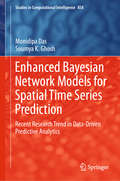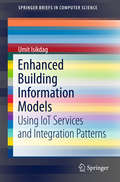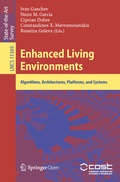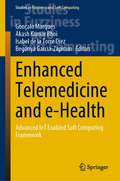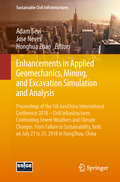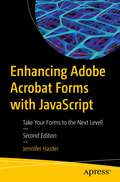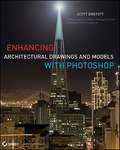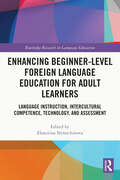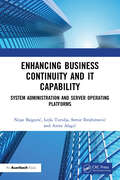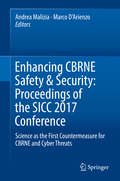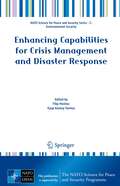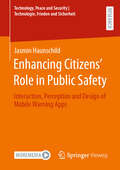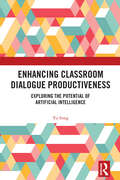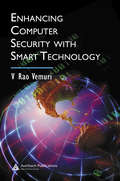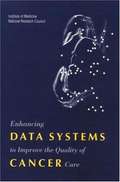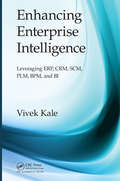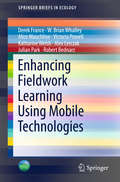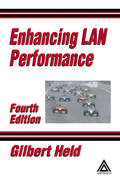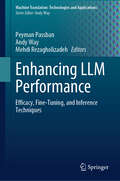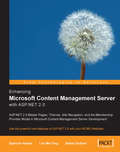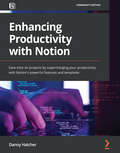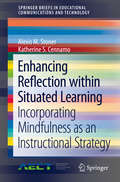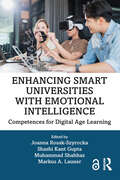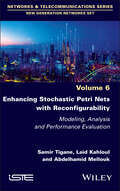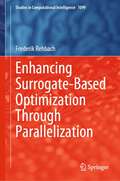- Table View
- List View
Enhanced Bayesian Network Models for Spatial Time Series Prediction: Recent Research Trend in Data-Driven Predictive Analytics (Studies in Computational Intelligence #858)
by Soumya K. Ghosh Monidipa DasThis research monograph is highly contextual in the present era of spatial/spatio-temporal data explosion. The overall text contains many interesting results that are worth applying in practice, while it is also a source of intriguing and motivating questions for advanced research on spatial data science. The monograph is primarily prepared for graduate students of Computer Science, who wish to employ probabilistic graphical models, especially Bayesian networks (BNs), for applied research on spatial/spatio-temporal data. Students of any other discipline of engineering, science, and technology, will also find this monograph useful. Research students looking for a suitable problem for their MS or PhD thesis will also find this monograph beneficial. The open research problems as discussed with sufficient references in Chapter-8 and Chapter-9 can immensely help graduate researchers to identify topics of their own choice. The various illustrations and proofs presented throughout the monograph may help them to better understand the working principles of the models. The present monograph, containing sufficient description of the parameter learning and inference generation process for each enhanced BN model, can also serve as an algorithmic cookbook for the relevant system developers.
Enhanced Building Information Models
by Umit IsikdagThis book explains how to combine and exploit sensor networks and internet-of-things (IoT) technologies and Web-service design patterns to enrich and integrate Building Information Models (BIMs). It provides approaches and software architectures for facilitating the interaction with (and between) BIMs through Web services, and for enabling and facilitating the fusion of the information residing in such models or of information acquired from IoT technologies. The proposed software architectures are presented in the form of design patterns. This information fusion will facilitate many novel application fields ranging from emergency response, to urban monitoring and surveillance, and to smart buildings. The book consists of 8 chapters. The first 2 chapters focus on the basics of BIMs, while chapter 3 presents fundamental service-oriented architecture patterns for complex information models. Subsequently, chapters 4 and 5 elaborate on the hardware and software side of IoT, with a special focus on their use for BIMs. Chapter 6 provides advanced SOA patterns for BIMs, while chapter 7 details patterns for IoT, and for BIM and IoT information fusion. Lastly, chapter 8 summarizes the work and provides an outlook on promising future developments. Overall, the book will be beneficial for researchers and developers in the fields of building information models, IoT applications, and systems integration.
Enhanced Living Environments: Algorithms, Architectures, Platforms, and Systems (Lecture Notes in Computer Science #11369)
by Ivan Ganchev Constandinos X. Mavromoustakis Rossitza Goleva Ciprian Dobre Nuno M. GarciaThis open access book was prepared as a Final Publication of the COST Action IC1303 “Algorithms, Architectures and Platforms for Enhanced Living Environments (AAPELE)”. The concept of Enhanced Living Environments (ELE) refers to the area of Ambient Assisted Living (AAL) that is more related with Information and Communication Technologies (ICT). Effective ELE solutions require appropriate ICT algorithms, architectures, platforms, and systems, having in view the advance of science and technology in this area and the development of new and innovative solutions that can provide improvements in the quality of life for people in their homes and can reduce the financial burden on the budgets of the healthcare providers.The aim of this book is to become a state-of-the-art reference, discussing progress made, as well as prompting future directions on theories, practices, standards, and strategies related to the ELE area. The book contains 12 chapters and can serve as a valuable reference for undergraduate students, post-graduate students, educators, faculty members, researchers, engineers, medical doctors, healthcare organizations, insurance companies, and research strategists working in this area.
Enhanced Telemedicine and e-Health: Advanced IoT Enabled Soft Computing Framework (Studies in Fuzziness and Soft Computing #410)
by Akash Kumar Bhoi Gonçalo Marques Isabel de la Torre Díez Begonya Garcia-ZapirainIn recent years, new applications on computer-aided technologies for telemedicine have emerged. Therefore, it is essential to capture this growing research area concerning the requirements of telemedicine. This book presents the latest findings on soft computing, artificial intelligence, Internet of Things and related computer-aided technologies for enhanced telemedicine and e-health. Furthermore, this volume includes comprehensive reviews describing procedures and techniques, which are crucial to support researchers in the field who want to replicate these methodologies in solving their related research problems. On the other hand, the included case studies present novel approaches using computer-aided methods for enhanced telemedicine and e-health. This volume aims to support future research activities in this domain. Consequently, the content has been selected to support not only academics or engineers but also to be used by healthcare professionals.
Enhancements in Applied Geomechanics, Mining, and Excavation Simulation and Analysis: Proceedings of the 5th GeoChina International Conference 2018 – Civil Infrastructures Confronting Severe Weathers and Climate Changes: From Failure to Sustainability, held on July 23 to 25, 2018 in HangZhou, China (Sustainable Civil Infrastructures)
by Adam Sevi Jose Neves Honghua ZhaoThe book presents a compilation of studies regarding applied geomechanics, mining, and excavation analysis and simulation. The material is suitable for presentation to senior undergraduate and post-graduate students in both mining and geological engineering. It should also be of interest to students of other aspects of Geomechanics and, notably, engineering geologists interested in mining and underground excavation design. Practising mining engineers and rock mechanics engineers involved in mine design may use the book profitably to obtain an appreciation of the current state of engineering knowledge in their area of specialisation. Papers were selected from the 5th GeoChina International Conference on Civil Infrastructures Confronting Severe Weathers and Climate Changes: From Failure to Sustainability, held in July 23-25, 2018 in Hang Zhou, China.
Enhancing Adobe Acrobat Forms with JavaScript: Take Your Forms to the Next Level!
by Jennifer HarderTake your PDF forms to the next level! In this book, you’ll learn various ways to further improve your PDF forms using simple JavaScript coding. You’ll also discover how a few lines of code can speed up your workflow when working with multiple PDFs in Action Wizard. Enhancing Adobe Acrobat Forms with JavaScript covers up-to-date, real working examples that you can easily download and practice with and edit to suit your own projects. This book also shows workarounds and solutions to various form issues you might encounter. Feel empowered by it and improve your PDF documents! JavaScript has been a part of Adobe Acrobat for many versions. However, few people use its features and focus mainly on using basic form properties, never delving deeper into Acrobat’s full capabilities. While information on the web can be helpful, if you don’t know enough about how to use JavaScript in Acrobat you will be left with poor results. JavaScript can be difficult to learn, but it does not need to be scary. This book explains in simple steps for beginner to intermediate level so that you can take full advantage of Acrobat’s capabilities for your own projects. What You Will Learn • Learn simplified field notation and basic JavaScript for Acrobat • Work with buttons that can be used for navigation • Improve form navigation and printing of forms • Add various types of alerts and custom validations to improve client-entered-data • Learn the basics of how to prepare a form for e-signingWho Is This Book ForThis book is for anyone who needs to create forms for clients or websites. Students, lawyers, accountants, and human resources will be able to take their work to the next level by streamlining their workflow and utilizing advanced JavaScript features in Adobe Acrobat.
Enhancing Architectural Drawings and Models with Photoshop
by Scott OnstottTransform your CAD drawings into powerful presentationThis one-of-a-kind book shows you how to use Photoshop to turn CAD drawings and BIM models into artistic presentations with captivating animations, videos, and dynamic 3D imagery. The techniques apply to all leading architectural design software including AutoCAD, Revit, and 3ds Max Design. Video tutorials on the DVD improve your learning curve and let you compare your work with the author's.Turn CAD drawings and BIM models into powerful presentations featuring animation, videos, and 3D imagery for enhanced client appealCraft interactive panoramas for your Web site, add people and objects to your models, and integrate 3D object models inside architectural interiorsBuild 3D models from photos and turn them into videos with AfterEffects, add depth of field and atmospheric effects to 3D models, create stereographic images, and much moreSee how it's done with the video tutorials on the DVDTake full advantage of Photoshop's power to present your architectural drawings in a new and exciting way.
Enhancing Beginner-Level Foreign Language Education for Adult Learners: Language Instruction, Intercultural Competence, Technology, and Assessment (Routledge Research in Language Education)
by Ekaterina NemtchinovaThis book is an authoritative text that explores best classroom practices for engaging adult learners in beginner-level foreign language courses. Built around a diverse range of international research studies and conceptual articles, the book covers four key issues in teaching language to novice students: development of linguistic skills; communicative, and intercultural competence; evaluation and assessment; and the use of technology. Each chapter includes teaching insights that are supported by critical research and can be practically applied across languages to enhance instructional strategies and curriculum designs. The text also aims to build intercultural competence, harness technology, and design assessment to stimulate effective learning in formal instructional settings including colleges, universities, and specialist language schools. With its broad coverage of language pedagogy at the novice level, this book is a must read for graduate students, scholars, researchers, and practitioners in the fields of language education, second language acquisition, language teaching and learning, and applied linguistics.
Enhancing Business Continuity and IT Capability: System Administration and Server Operating Platforms
by Nijaz Bajgorić Lejla Turulja Semir Ibrahimović Amra AlagićEnterprise servers play a mission-critical role in modern computing environments, especially from a business continuity perspective. Several models of IT capability have been introduced over the last two decades. Enhancing Business Continuity and IT Capability: System Administration and Server Operating Platforms proposes a new model of IT capability. It presents a framework that establishes the relationship between downtime on one side and business continuity and IT capability on the other side, as well as how system administration and modern server operating platforms can help in improving business continuity and IT capability. This book begins by defining business continuity and IT capability and their importance in modern business, as well as by giving an overview of business continuity, disaster recovery planning, contingency planning, and business continuity maturity models. It then explores modern server environments and the role of system administration in ensuring higher levels of system availability, system scalability, and business continuity. Techniques for enhancing availability and business continuity also include Business impact analysis Assessing the downtime impact Designing an optimal business continuity solution IT auditing as a process of gathering data and evidence to evaluate whether the company’s information systems infrastructure is efficient and effective and whether it meets business goals The book concludes with frameworks and guidelines on how to measure and assess IT capability and how IT capability affects a firm’s performances. Cases and white papers describe real-world scenarios illustrating the concepts and techniques presented in the book.
Enhancing CBRNE Safety & Security: Science As The First Countermeasure For Cbrne And Cyber Threats
by Andrea Malizia Marco D’ArienzoThis book presents the proceedings of SICC 2017, a conference devoted to promoting the dissemination of the different methodologies, techniques, theories, strategies, technologies and best practices on the prevention and mitigation of CBRNE risks. As the first scientific international conference on safety & security issues in the CBRNE field, SICC 2017 attracted contributions resulting from fruitful inter-professional collaborations between university and military experts, specialized operators, decision makers and the industry. As such, these proceedings are primarily intended for academics and professionals from public, private and military entities. It is the first trans-disciplinary collection of scientific papers from the numerous fields related to CBRNE.
Enhancing Capabilities for Crisis Management and Disaster Response (NATO Science for Peace and Security Series C: Environmental Security)
by Eyup Kuntay Turmus Filip HostiucScience for Peace and Security (SPS) cooperation brings together NATO & partners to address common security concerns reflected in the so-called SPS Key Priorities. These include emerging security challenges such as terrorism, cyber defense or energy security, as well as human and social aspects of security, support to NATO-led mission and operation, advanced technologies with security applications, and early warning. The SPS project “Advanced Civil Emergency Coordination Pilot in the Western Balkans” addresses several of these areas. As a key regional SPS flagship project, it helps to build capacity in response to a concrete security challenge. The Western Balkans is a region frequently affected by natural disasters and the pilot project provides emergency responders in the region with an incident command system that allows sharing information about disasters in a fast and easy way, enhancing situational awareness and building capacity in the area of civil emergency coordination.
Enhancing Citizens’ Role in Public Safety: Interaction, Perception and Design of Mobile Warning Apps (Technology, Peace and Security I Technologie, Frieden und Sicherheit)
by Jasmin HaunschildThe COVID-19 pandemic and the war in Ukraine emphasize the need for greater disaster resilience and preparedness. This book investigates how these apps can enhance crisis awareness and citizen involvement in disaster prevention and response. By examining user perspectives and the impact of crisis experiences, the book explores how to increase the adoption and effectiveness of warning apps. The research uses qualitative and quantitative methods, including surveys and design interventions, to reveal current usage, changes over time and desired features. It shows that while citizens find warning apps helpful, more safety-related features and two-way communication could increase their appeal. Additionally, the integration of preparedness features into these apps can increase their perceived usefulness, though challenges remain in addressing user expectations and design preferences across different crises and cultural contexts.
Enhancing Classroom Dialogue Productiveness: Exploring the Potential of Artificial Intelligence
by Yu SongThis book demonstrates how artificial intelligence (AI) can be used to uncover the patterns of classroom dialogue and increase the productiveness of dialogue.In this book, the author uses a range of data mining techniques to explore the productive features and sequential patterns of classroom dialogue. She analyses how the Large Language Model (LLM) as an AI technique can be adapted to enhance dialogue contributions. The book also includes valuable feedback and practical cases from teachers and their dialogue transcripts, facilitating an understanding of AI use and pedagogical development.This book makes original contributions to the field of classroom dialogue and technology, and it will encourage scholars making similar attempts at technological infusion for pedagogical improvement.
Enhancing Computer Security with Smart Technology
by V. Rao VemuriDivided into two major parts, Enhancing Computer Security with Smart Technology introduces the problems of computer security to researchers with a machine learning background, then introduces machine learning concepts to computer security professionals. Realizing the massive scope of these subjects, the author concentrates on problems relat
Enhancing Data Systems to Improve the Quality of Cancer Care
by Institute of MedicineOne of the barriers to improving the quality of cancer care in the United States is the inadequacy of data systems. Out-of-date or incomplete information about the performance of doctors, hospitals, health plans, and public agencies makes it hard to gauge the quality of care. Augmenting today's data systems could start to fill the gap.This report examines the strengths and weaknesses of current systems and makes recommendations for enhancing data systems to improve the quality of cancer care. The board's recommendations fall into three key areas: Enhance key elements of the data system infrastructure (i.e., quality-of-care measures, cancer registries and databases, data collection technologies, and analytic capacity). Expand support for analyses of quality of cancer care using existing data systems. Monitor the effectiveness of data systems to promote quality improvement within health systems.
Enhancing Enterprise Intelligence: Leveraging ERP, CRM, SCM, PLM, BPM, and BI
by Vivek KaleEnhancing Enterprise Intelligence: Leveraging ERP, CRM, SCM, PLM, BPM, and BI takes a fresh look at the benefits of enterprise systems (ES), focusing on the fact that ES collectively contribute to enhancing the intelligence quotient of an enterprise. The book provides an overview of the characteristic domains (i.e., business functions, processes, a
Enhancing Fieldwork Learning Using Mobile Technologies
by Robert Bednarz Derek France W. Brian Whalley Alice Mauchline Victoria Powell Katharine Welsh Alex Lerczak Julian ParkThis book shows how tablets (and smartphones) using a variety of selected 'apps', can enhance fieldwork and other out-of-classroom activities. The authors review imaginative uses of tablets from their own project and as well as examples from other colleagues. To help readers keep abreast of new technology and innovative ways to use it, the book is supported by a web site and a social media community.
Enhancing LAN Performance
by Gilbert HeldEnhancing LAN Performance, Fourth Edition explains how to connect geographically separated LANs with appropriate bandwidth, the issues to consider when weighing the use of multiport or dualport devices, how to estimate traffic for new networks, the effects of configuration changes on the performance of Ethernet and Token Ring networks, the design o
Enhancing LLM Performance: Efficacy, Fine-Tuning, and Inference Techniques (Machine Translation: Technologies and Applications #7)
by Andy Way Peyman Passban Mehdi RezagholizadehThis book is a pioneering exploration of the state-of-the-art techniques that drive large language models (LLMs) toward greater efficiency and scalability. Edited by three distinguished experts—Peyman Passban, Mehdi Rezagholizadeh, and Andy Way—this book presents practical solutions to the growing challenges of training and deploying these massive models. With their combined experience across academia, research, and industry, the authors provide insights into the tools and strategies required to improve LLM performance while reducing computational demands. This book is more than just a technical guide; it bridges the gap between research and real-world applications. Each chapter presents cutting-edge advancements in inference optimization, model architecture, and fine-tuning techniques, all designed to enhance the usability of LLMs in diverse sectors. Readers will find extensive discussions on the practical aspects of implementing and deploying LLMs in real-world scenarios. The book serves as a comprehensive resource for researchers and industry professionals, offering a balanced blend of in-depth technical insights and practical, hands-on guidance. It is a go-to reference book for students, researchers in computer science and relevant sub-branches, including machine learning, computational linguistics, and more.
Enhancing Microsoft Content Management Server with ASP.NET 2.0
by Lim Mei YingThe book is written for developers who work with Microsoft Content Management Server, and want to update their skills to take advantage of the latest offerings in ASP.NET. If you are an MCMS developer who hasn't yet got into ASP.NET 2.0, this book is an ideal introduction to the most exciting features of ASP.NET 2.0, and how you can make them work for you.
Enhancing Productivity with Notion: Save time on projects by supercharging your productivity with Notion's powerful features and templates
by Danny HatcherWritten by an experienced Notion Ambassador, this book helps you become proficient with the features, functions, and flexibility of the Notion app to make work and personal life easierKey FeaturesCreate accounts, workspaces, and dashboards using all of Notion's flexible featuresDevelop the skills you need to work in various contexts, while working collaboratively with othersUse basic and advanced blocks, databases, and functions to optimize a workflow that works for youBook DescriptionNotion is note-taking, wiki management, and task and project management software that gives you control of your working environment. By creating pages using a variety of block types and database styles, the possibilities are endless. This book will help you overcome challenges in managing large projects using Notion and creating documents using real-time updates with a great deal of flexibility, allowing everyone to have a customized view as per their needs.With this book, you'll become well-versed with Notion, where you'll learn how to access, create, and change a workspace utilizing all the blocks, database views and properties, and advanced features and functions. From a table or list view to a Kanban board or gallery view, you'll get to explore several database options available in Notion. You'll learn the skills to build pages, customize the aesthetics, create templates, and store, organize, and surface information through databases, all while building a system and workflow that works for you in your context. The book will also demonstrate how to import and export information and combine Notion with other tools using the API.By the end of this book, you'll be able to create a task management system, project management system, or any other system while combining it with other tools that speed up your work for better efficiency.What you will learnUnderstand how to set up and build on any deviceNavigate, share and alter the appearance of your workspaceImport and export data to and from NotionUnderstand how to use all the database views, filters, sorts, and propertiesCreate task, wiki, and project management systemsConnect Notion to third-party applications with the APIWho this book is forBusiness users, power users, IT professionals, or anyone from a non-technical background looking to use Notion to increase their productivity will find this note-taking book useful.
Enhancing Reflection within Situated Learning: Incorporating Mindfulness As An Instructional Strategy (Springerbriefs In Educational Communications And Technology Ser.)
by Alexis M. Stoner Katherine S. CennamoThis innovative brief provides guidance on promoting reflection in situated learning by incorporating mindfulness strategies, tapping into a surge of research interest in exploring mindfulness as an instructional strategy associated with positive learning outcomes. It illustrates the benefits of continuous reflection within situated learning and how mindfulness can be incorporated before, during, and after the learning experience to enhance the reflective experience. Critically, the authors present a new conceptual model that synthesizes theories and methods from three different areas of study—mindfulness, situated learning, and reflection— to provide a new perspective and instructional approach that has great potential to positively impact outcomes in situated learning.Among the other topics covered:• Strategies for reflection in situated learning.• Strategies for reflection-in-action in situated learning.• Mindfulness strategies for situated learning.• A conceptual model incorporating mindfulness to enhance reflection.Enhancing Reflection within Situated Learning is an exciting and pioneering resource that offers practical guidance to educators and instructional designers interested in incorporating methods and approaches for integrating mindfulness and reflection across instructional environments.
Enhancing Smart Universities with Emotional Intelligence: Competences for Digital Age Learning
by Markus A. Launer Muhammad Shahbaz Shashi Kant GuptaEnhancing Smart Universities with Emotional Intelligence investigates the successful blending of technology innovations and human beings’ emotional intelligence within higher education institutions in the midst of digital transformation. Today’s “smart” universities improve student experiences, expedite administrative procedures, and facilitate individualized learning pathways by integrating a variety of cutting-edge technologies such as machine learning, big data analytics, immersive and wearable learning tools, digital management systems, and cloud computing. But how can leaders and administrators ensure that these advancements don’t come at the expense of positive experiences and relationships among students and faculty? Built from theoretical frameworks, case studies, and empirical research, this book offers a thorough manual for comprehending the crucial nexus of technology and human abilities to enable dynamic and sustainable learning environments. Each chapter is essential for college and university leaders, administrators, and policymakers around the world who are charged with ensuring that human talents and digital technologies are properly balanced for the best possible learning experiences.Chapter 1 of this book is freely available as a downloadable Open Access PDF at http://www.taylorfrancis.com under a Creative Commons Attribution-Non Commercial-No Derivatives (CC BY-NC-ND) 4.0 license.
Enhancing Stochastic Petri Nets with Reconfigurability: Modeling, Analysis and Performance Evaluation (ISTE Invoiced)
by Abdelhamid Mellouk Samir Tigane Laid KahloulThis book explores the world of reconfigurable stochastic Petri nets (RSPNs), a powerful method for modeling and verifying complex, dynamic and reconfigurable systems. As modern discrete-event systems become increasingly flexible, requiring structural adaptability at runtime, classical Petri nets are proving insufficient. This book presents innovative extensions to Petri nets, offering enhanced modeling capabilities for reconfigurable systems, while ensuring efficient verification. Through a structured approach, this book introduces reconfigurable generalized stochastic Petri nets (RecGSPNs), an advanced framework that integrates reconfigurability while preserving crucial system properties such as liveness, boundedness and deadlock-freedom. This book systematically explores modeling techniques, including stochastic reward nets and dynamic topology transformations, demonstrating their effectiveness through quantitative and qualitative analyses. By addressing challenges in state-space explosion and computational complexity, this book provides essential methodologies for researchers and practitioners working on reconfigurable systems, and serves as a valuable resource for those working in network security, manufacturing systems and distributed computing, where dynamic reconfigurations are essential.
Enhancing Surrogate-Based Optimization Through Parallelization (Studies in Computational Intelligence #1099)
by Frederik RehbachThis book presents a solution to the challenging issue of optimizing expensive-to-evaluate industrial problems such as the hyperparameter tuning of machine learning models. The approach combines two well-established concepts, Surrogate-Based Optimization (SBO) and parallelization, to efficiently search for optimal parameter setups with as few function evaluations as possible.Through in-depth analysis, the need for parallel SBO solvers is emphasized, and it is demonstrated that they outperform model-free algorithms in scenarios with a low evaluation budget. The SBO approach helps practitioners save significant amounts of time and resources in hyperparameter tuning as well as other optimization projects. As a highlight, a novel framework for objectively comparing the efficiency of parallel SBO algorithms is introduced, enabling practitioners to evaluate and select the most effective approach for their specific use case.Based on practical examples, decision support is delivered, detailing which parts of industrial optimization projects can be parallelized and how to prioritize which parts to parallelize first. By following the framework, practitioners can make informed decisions about how to allocate resources and optimize their models efficiently.
